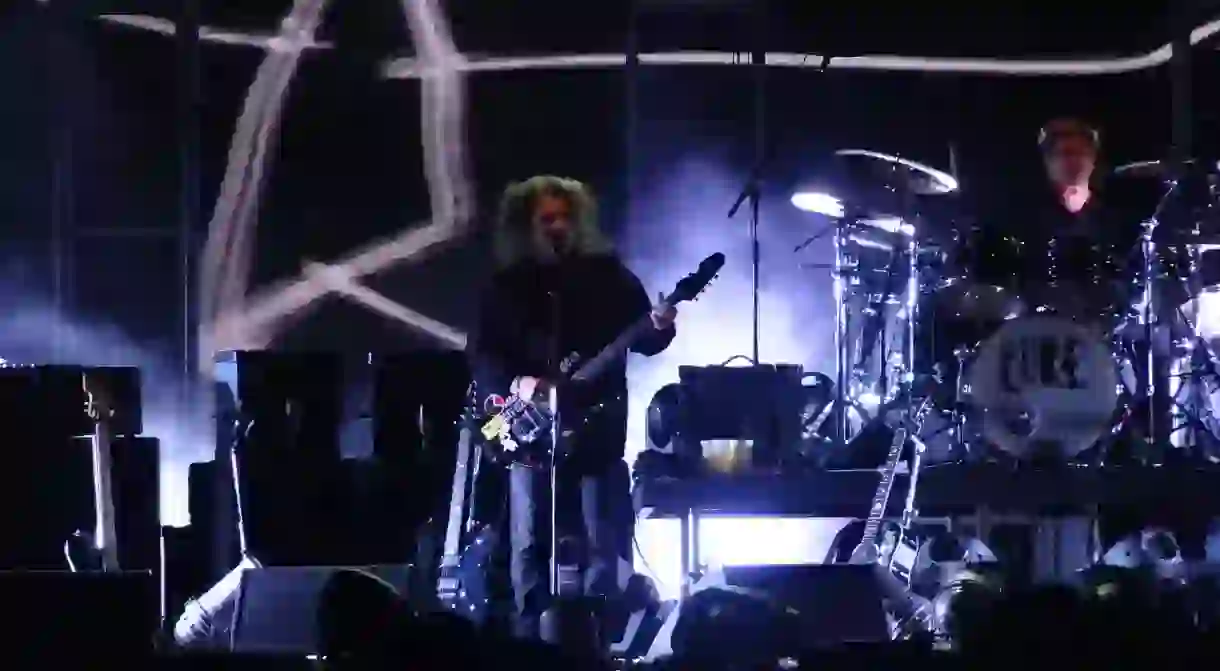An Introduction To The Cure In 10 Songs

The ’80s was an era full of fantastic and forward-thinking music, but also plenty of bland and one-dimensional tunes. Luckily there were a few bands that stood well above the rest, The Cure being among the best. Known as one of the most versatile alternative rock bands of all time, we guide you through 10 of the greatest tracks produced by this sensational group of musicians.
Jumping Someone Else’s Train (1979)
This song totally deserves more attention than it gets; it’s a wonderfully tact prototype for the more raucous world of punk that would bloom later in the ’80s. The band plays with cutthroat precision, but the energy is still raw and messy, with every instrument (including Robert Smith’s voice) piercing through at every turn. The Cure manages to harness a punk energy without the gimmicky rambunctiousness of so many early punk peers.
A Strange Day (1982)
With ‘A Strange Day,’ The Cure channeled their new wave finesse spectacularly, making the most of every eerie minimal element of sound. The bass line hardly strays from its progression, and the guitar sounds a cooing, one-note melody that interplays with heavy organ synth patches that sound as if they’re bouncing off of church walls. This is some alone-in-the-dark kind of stuff, but it never sacrifices excellent songwriting.
https://www.youtube.com/watch?v=TyG3AtzN1OM
Doubt (1981)
Everything about this song proves The Cure’s versatility as songwriters. ‘Doubt’ has a heavy shifting bass line that keeps the entire song dancing very much in a two-tone ska way that brings The Specials or Madness to mind, but always remaining distinctively The Cure. Meanwhile, the guitars and vocals radiate a chilling echo that is indicative of what would become Sonic Youth’s Daydream Nation or the aesthetic tenets of shoegaze.
https://www.youtube.com/watch?v=iBri3WY2Fs4
Close to Me (1985)
As sharp left turn, ‘Close to Me’ was momentous for the band in 1985. Not only was it one of their most successful crossover singles, it signaled a new creative era for them. With this single and the album The Head on the Door, The Cure displayed a sharp pop songwriting capability that was far off from the droning, lengthy, and dark new wave sound they had been honing for six years. Very much of its time, ‘Close to Me’ features frenetic trumpet blasts and saxophone interplays that will get your head spinning, layered over the sweetest little melody from a xylophone and a simple synth patch. Robert Smith sounds his most earnest and urgent.
https://www.youtube.com/watch?v=IKvXusoS6ww
A Forest (1981)
It’s important to spend some time with The Cure’s dancier side. Sure, they played the new wave sound better than almost any other band in the game at the time, but that sound was so deep that in some instances, songs almost became darkly lithe club hits. ‘A Forest’ opens with the kind of synth line you expect to hear before a major bass drop, and then suddenly it all drops into the iciest guitar melody intro, slowing layering into one of the most dance-informed song of the band’s career. No song better encapsulates dying your hair black and getting down on the dance floor.
https://www.youtube.com/watch?v=dzFmlRCyVUs
Disintegration (1989)
Not all long songs are the same. Some definitely feel long, but then there are those songs that are just so engaging and intense that 10 minutes could run right past you. ‘Disintegration’ is one of those long songs. One of the last tracks on their critical darling album of the same name, this song literally sounds like the soundtrack to the ‘big break up.’ The larger-than-life chord progression and Smith’s heart-wrenching yelp over the eight and half minutes all collide with a dissonant intensity. Really makes for good listening, though; I promise.
Just Like Heaven (1987)
A counterpoint to ‘Disintegration,’ ‘Just Like Heaven’ conjures an insular, emotional end-of-the-world, in a much sweeter and more infectious way. The Cure absolutely hit a songwriting apex with this gem, with the kind of strumming simplicity and melodious harmonizing that would come to influence countless artists all across the musical spectrum. Furthermore, the band manages to capture gushing romance and post-love heartache all in a perfect three and a half minutes. It’s perfect for shedding a tear and driving with the windows down on a summer night.
https://www.youtube.com/watch?v=8Dhn_iIQXDE
Dressing Up (1984)
‘Dressing Up’ plays out the much more rhythmic, soulful side of the synthesizer spectrum. One listen to this song gives all sorts of context to ‘chillwave’ artists like Toro y Moi. ‘Dressing Up’ utilizes some bass work pertinent to funk and soul from the decade before, and the synths are impressively fleshed out, with a constantly rush of brief arpeggiated flourishes and… pan flute?
The Walk (1983)
‘The Walk’ is almost a house/new wave anthem. Fat, happy-hardcore synths boom out between verses, with ghostly leads and harmonies gliding just underneath the vocals, and the drums pump the song on ferociously with the steady 4/4 boom-bap that makes dance music so entrancing.
Lullaby (1989)
‘Lullaby’ is the song that illuminates The Cure’s songwriting prowess better than any other song they have written. The softness of the delayed guitar and whispers suck you into the warmth, and then the drums and bass kick into a groove that is borderline sensual. The string patches coo and ensnare, and the vocals come in for the kill. Robert Smith delivers one of his most outstanding performances on this song, with a whispering drone that immediately summons a claustrophobic feeling and keeps you tied up in a web of eerie smoothness until the whole song comes to a sharp close. Talk about skills.













